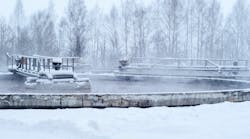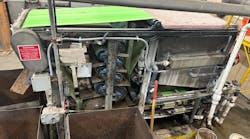The Joint Abbotsford Mission Environment System (JAMES) Wastewater Treatment Plant (WWTP) is co-owned by the city of Abbotsford, BC, Canada and the District of Mission. Governance is provided through the Abbotsford/Mission Water and Sewer Commission (AMWSC), which is comprised of elected representatives and employees of the city of Abbotsford and the District of Mission. The city of Abbotsford is the operator of the JAMES WWTP.
Constructed in 1981, the JAMES WWTP is located south of the Fraser River in the city of Abbotsford. It serves communities including Abbotsford, Mission and Sumas, which is in Washington state. The liquid train of the JAMES WWTP includes influent pumping, headworks screening, aerated grit removal, primary sedimentation, trickling filter/solids contact process, secondary clarification and disinfection. The treated effluent is discharged into a high-current area of the Fraser River through a 1.2-km-long outfall. Solids handling includes thickening of secondary sludge, pre-pasteurization, mesophilic digestion and solids dewatering. Class A biosolids are produced as a result of the pasteurization and the digestion process.
In 2010, approximately 70% of the biosolids produced were transported to a mine site in interior British Columbia for reclamation, and the remaining 30% was used on site to produce a growing medium (topsoil) sold under the Val-E-Gro name. A soil biofilter system is used for odor control and treatment.
Current Practice
Currently, two belt filter presses (BFPs) are used for solids dewatering. BFPs are continuous-fed dewatering devices that use the principles of chemical conditioning, gravity drainage and mechanically applied pressure to dewater biosolids. The solids content of the biosolids dewatered by the two BFPs was initially 21%, but decreased to 19% starting in 2006.
The two BFPs were installed in 1993 and have reached the end of their natural service lives. In addition, the presses cannot accommodate the growth projected for the Fraser Valley over the next 25 years. The number of equivalent population served by the WWTP is projected to increase from 266,000 in 2009 to 488,000 by 2034—nearly doubled. For these reasons, coupled with the decreased solids content produced by the BFPs, the AMWSC realized that it was time to upgrade the solids dewatering process.
Evaluation of Technologies
Several solids dewatering options available in the market were evaluated through a series of engineering studies. These included the BFPs, centrifuges and various presses. A number of factors were considered, including staffing needs, footprint and loading, electrical upgrade requirements and the overall costs of implementation and operation. Furthermore, an expert analysis was used to incorporate the feedback from the plant’s personnel. Centrifuges were chosen as the final recommendation.
The centrifuge technology was shown to offer benefits over the current BFP technology at the JAMES WWTP. Centrifuges are capable of producing biosolids with higher solids content than BFPs. It is anticipated that the centrifuges will produce biosolids of 25% solids content. The drier cake results in a 32% reduction in overall tonnage that needs to be transported to the mine reclamation site and reduces the number of trips. The benefits are twofold: transportation cost savings and reduction in greenhouse gas (GHG) emission due to trucking. For example, in 2011, there would be 43 fewer round trips with the use of centrifuges, which would save $50,000 in transportation costs and reduce 68,000 kg of GHG emission due to trucking. Over the next 25 years, the city of Abbotsford could see an overall GHG emission reduction of 2,400,000 kg and transportation cost reduction of $1.8 million.
The centrifuge technology increases reliability, operational performance and capacity of the dewatering process to produce biosolids that exceed current environmental standards. This technology meets permit requirements and the demands of the expected population growth in the region.
A drier biosolids cake is easier to work with in the preparation of Val-E-Gro. A drier cake also improves the public acceptability for reuse in landscaping and gardening applications.
Finally, the use of centrifuges eliminates exposure to off-gasses that are produced using the existing BFP technology, and they improve the JAMES WWTP’s health and safety conditions.
Project Greening
A number of green features were included in the design of the biosolids dewatering project:
- A second story was added onto the existing building to house the new centrifuges. This design maximizes the use of the existing plant footprint and minimizes disturbance to the surrounding environment (e.g., fish and wildlife habitat). Addition of a second story also minimizes the amount of new building materials required for the upgrade.
- The building includes energy-efficient light fixtures with motion sensors to provide lighting only when the space is occupied.
- Foul air is extracted directly from the centrifuge equipment and discharged to the existing odor control/treatment system. This reduces the energy demand and defers the need to upgrade the odor control system.
- The HVAC system is designed to minimize the amount of general ventilation, reduce heating loads through low temperature set points (e.g., 10°C in winter) and provide free cooling in summer. The design approach reduces energy consumption and operating costs.
Summary
To date, two centrifuges have been installed and are being commissioned at the JAMES WWTP. Once completed, the city of Abbotsford and District of Mission will see cost savings and a reduction in GHGs due to reduced trucking as a result of the drier solids produced by the centrifuges.
Download: Here

